The Passenger Vessel Propeller Market is estimated to be valued at USD 758.9 million in 2025 and is projected to reach USD 1123.3 million by 2035, registering a compound annual growth rate (CAGR) of 4.0% over the forecast period. This growth is supported by increasing demand for passenger vessels, including ferries, cruise ships, and other marine transportation, particularly in regions with expanding tourism and urban development. In the first five-year phase (2025–2030), the market is expected to grow from USD 758.9 million to USD 911.9 million, adding USD 153 million, which accounts for 42% of the total incremental growth.
The second phase (2030–2035) is expected to contribute USD 211.4 million, representing 58% of the total growth, driven by stronger momentum as demand for sustainable, energy-efficient, and high-performance propellers increases. Annual increments will rise from USD 31 million in the early years to USD 42 million by 2035, reflecting an accelerated pace of growth driven by advancements in marine technology, regulations, and the increase in cruise and ferry travel. Manufacturers focusing on optimizing propeller designs for fuel efficiency and low environmental impact will capture the largest share of this USD 364.4 million opportunity.
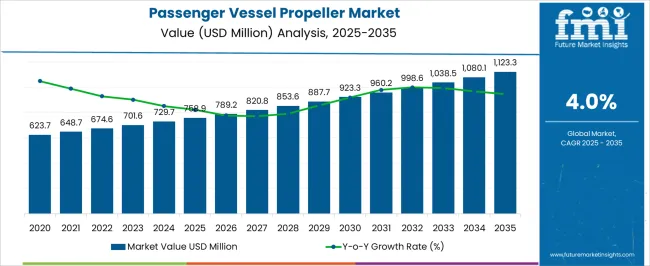
| Metric | Value |
|---|---|
| Passenger Vessel Propeller Market Estimated Value in (2025 E) | USD 758.9 million |
| Passenger Vessel Propeller Market Forecast Value in (2035 F) | USD 1123.3 million |
| Forecast CAGR (2025 to 2035) | 4.0% |
The passenger vessel propeller market is experiencing strong growth due to increasing investments in cruise tourism, maritime transport modernization, and environmentally compliant propulsion technologies. Governments and commercial operators are emphasizing low-emission and energy-efficient marine systems, which has intensified the shift toward high-performance propeller designs and materials. Technological advancements in CFD-based hydrodynamic optimization, along with integrated propulsion control systems, are contributing to greater adoption of customized propeller configurations that enhance maneuverability and operational efficiency.
Global fleet expansion, especially in the cruise and ferry segments, is further catalyzing demand for advanced propeller systems. Additionally, growing concerns over underwater noise pollution and fuel efficiency have encouraged the integration of smart propeller monitoring and condition-based maintenance technologies.
As international maritime regulations tighten around fuel consumption and emission standards, passenger vessels are increasingly being outfitted with propulsion systems that enable operational flexibility and life cycle efficiency This evolution is expected to continue shaping the market landscape, especially across high-traffic marine tourism corridors.
The passenger vessel propeller market is segmented by vessel, propeller type, material type, sales channel, and geographic regions. By vessel, the passenger vessel propeller market is divided into Cruise Ships, Ferries, Yachts, and River Cruise Vessels. In terms of propeller type, the passenger vessel propeller market is classified into Controllable Pitch Propellers (CPP), Fixed Pitch Propellers (FPP), Ducted Propellers, Azimuth Thrusters, and Others. Based on the material type, the passenger vessel propeller market is segmented into Nickel-Aluminum Bronze (NAB), Stainless Steel, Composites, and Others. By sales channel, the passenger vessel propeller market is segmented into OEMs and the Aftermarket. Regionally, the passenger vessel propeller industry is classified into North America, Latin America, Western Europe, Eastern Europe, Balkan & Baltic Countries, Russia & Belarus, Central Asia, East Asia, South Asia & Pacific, and the Middle East & Africa.
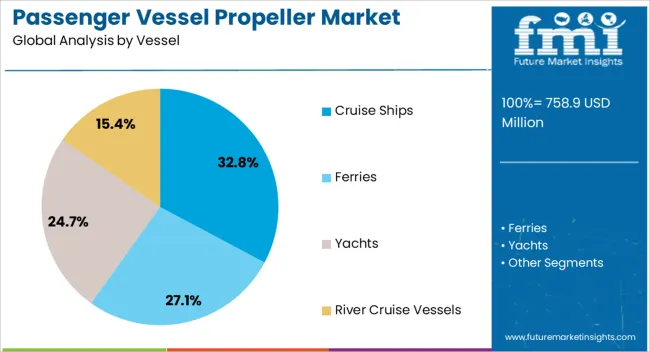
Cruise ships are expected to account for 32.8% of the revenue share in the passenger vessel propeller market in 2025, making this the most dominant vessel segment. This share is driven by the substantial increase in cruise ship construction and deployment across major tourism routes. Operators are focusing on enhancing propulsion efficiency to reduce operating costs while improving passenger comfort.
Cruise ships require propulsion systems that can operate quietly, deliver consistent performance over long distances, and accommodate frequent maneuvering in ports. These factors have led to the adoption of propeller designs that offer high thrust and reduced cavitation. Advanced propeller technologies are being integrated into newbuild vessels to meet IMO energy efficiency guidelines and to lower greenhouse gas emissions.
The cruise industry’s shift toward mega-ships with higher passenger capacities has also resulted in demand for larger, more durable propellers that maintain performance under varying load conditions. The operational flexibility provided by these systems has contributed to their strong preference among cruise operators globally.
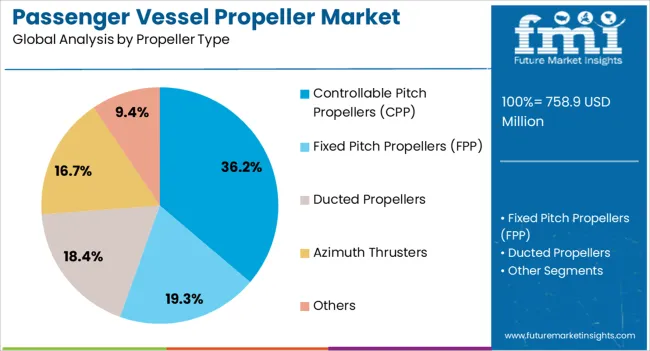
Controllable pitch propellers are projected to contribute 36.2% of the total revenue in the passenger vessel propeller market by 2025. The growing need for maneuverability, operational flexibility, and propulsion efficiency in dynamic maritime conditions is reinforcing the segment's dominance. These propellers allow real-time adjustment of blade angles, enabling vessels to optimize performance across varying speed and load requirements.
The preference for controllable pitch propellers has increased in vessels where precision docking, frequent speed changes, and energy optimization are essential. Cruise and passenger ferry operators are increasingly adopting these systems to align with environmental regulations and improve engine load management.
The integration of automation and digital control systems has enhanced the performance monitoring and predictive maintenance of CPPs, contributing to their long-term cost efficiency. Their ability to deliver smoother transitions and maintain consistent propulsion even under challenging sea states has established them as the preferred option for passenger vessels engaged in both coastal and international routes.
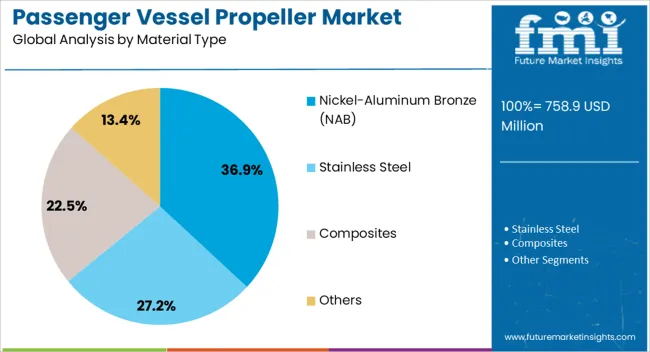
Nickel aluminum bronze materials are estimated to hold 36.9% of the passenger vessel propeller market share in 2025, reflecting their strong presence as the most favored material type. The widespread adoption of this alloy is being driven by its excellent corrosion resistance, mechanical strength, and durability in marine environments. These material properties have proven critical for propeller longevity, especially in saltwater operations where cavitation and biofouling pose significant challenges.
The enhanced structural integrity and resistance to erosion have made nickel-aluminum bronze an ideal choice for propellers used in long-duration voyages and harsh operating conditions. Its ability to withstand repeated stress without deformation supports extended operational life cycles and reduces maintenance intervals.
The material's compatibility with complex casting techniques and high-performance design tolerances has also facilitated the production of hydrodynamically efficient blades As operators seek materials that balance mechanical performance with cost-effectiveness, nickel aluminum bronze continues to be widely adopted for both retrofits and new shipbuilding programs.
The passenger vessel propeller market is fueled by rising demand from the tourism, transport, and cruise industries. Emerging opportunities in cruise tourism and regional shipping offer growth potential, while trends in eco-friendly and high-efficiency propellers continue to shape the market. Challenges such as high production costs and technological complexity remain. By 2025, addressing these challenges while capitalizing on the growing demand for efficient, sustainable propulsion systems will be key to the market’s success and long-term growth.
The passenger vessel propeller market is experiencing steady growth due to the increasing demand for passenger vessels in the tourism, transport, and cruise industries. The expansion of global travel, especially in regions like Europe, North America, and Asia-Pacific, is driving the need for efficient propulsion systems. As new vessels are being introduced to accommodate growing passenger numbers, there is an increasing need for advanced, reliable, and fuel-efficient propellers to improve the performance of these vessels. By 2025, the market is expected to continue benefiting from the growth of the maritime tourism and transport sectors.
The growing popularity of cruise tourism and the expansion of regional shipping fleets offer significant opportunities for the passenger vessel propeller market. With an increasing number of cruise lines catering to global travelers, the demand for advanced propeller systems to enhance vessel performance and reduce fuel consumption is rising. Furthermore, developing economies such as China and India are expanding their shipping industries to cater to growing domestic and international trade. By 2025, these markets will present key growth opportunities for manufacturers of passenger vessel propellers, especially in terms of supplying customized, high-efficiency solutions.
Emerging trends in the passenger vessel propeller market highlight the growing demand for eco-friendly, energy-efficient propulsion systems. Manufacturers are focusing on designing propellers that reduce fuel consumption and decrease the environmental impact of passenger vessels. Developments in alternative materials, such as composites and advanced alloys, are helping to increase the durability and performance of propellers. By 2025, the growing emphasis on reducing emissions and improving operational efficiency will push the market toward the adoption of green technologies, including more advanced and efficient propeller designs.
The passenger vessel propeller market faces challenges related to high production costs and technological complexity. The design and manufacturing of advanced propellers require significant investment in research and development to meet the evolving performance and efficiency requirements. The integration of new materials and advanced manufacturing processes further raises production costs, which can limit access to smaller manufacturers and regional players. Additionally, maintaining consistent quality and compliance with industry regulations can increase the complexity of operations. By 2025, overcoming these barriers will be essential for maintaining market competitiveness while offering innovative solutions.
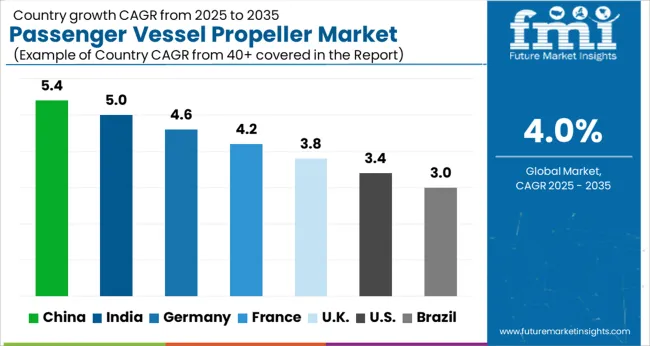
| Countries | CAGR |
|---|---|
| China | 5.4% |
| India | 5.0% |
| Germany | 4.6% |
| France | 4.2% |
| UK | 3.8% |
| USA | 3.4% |
| Brazil | 3.0% |
The global passenger vessel propeller market is projected to grow at a 4% CAGR from 2025 to 2035. China leads with a growth rate of 5.4%, followed by India at 5%, and France at 4.2%. The United Kingdom records a growth rate of 3.8%, while the United States shows the slowest growth at 3.4%. These varying growth rates are driven by the increasing demand for passenger vessels, advancements in marine propulsion technologies, and the rise in the cruise industry. Emerging markets like China and India are experiencing higher growth due to expanding tourism, maritime infrastructure, and rising demand for more efficient and sustainable marine propulsion systems. More mature markets like the USA and the UK see steady growth driven by technological advancements, sustainability regulations, and the increasing need for fuel-efficient and environmentally friendly marine propulsion solutions. This report includes insights on 40+ countries; the top markets are shown here for reference.
The passenger vessel propeller market in China is growing rapidly, with a projected CAGR of 5.4%. China’s expanding cruise industry, combined with rising demand for tourism, is driving the market for passenger vessels. The country’s growing focus on improving maritime infrastructure and enhancing the efficiency of passenger vessels, coupled with government policies promoting clean energy solutions and environmental sustainability, is accelerating the adoption of advanced passenger vessel propellers. Additionally, China’s strong manufacturing base and increasing investments in high-performance propulsion systems further contribute to market expansion. As the cruise and ferry markets grow, the demand for advanced, fuel-efficient, and environmentally friendly propellers is expected to rise.
The passenger vessel propeller market in India is projected to grow at a CAGR of 5%. India’s increasing investments in tourism, along with rising domestic and international passenger ferry services, is driving the demand for advanced passenger vessel propellers. The country’s growing maritime infrastructure and focus on improving port and shipping services continue to support market growth. Additionally, India’s commitment to sustainability and energy efficiency in its maritime industry contributes to the adoption of more fuel-efficient and environmentally friendly propellers. The rising popularity of cruises, both domestic and international, further accelerates market demand for passenger vessel propellers.

The passenger vessel propeller market in France is projected to grow at a CAGR of 4.2%. France’s growing demand for passenger ferries and cruise vessels, coupled with its strong maritime industry, continues to drive the market for propellers. The country’s increasing focus on sustainable marine solutions, particularly in the cruise industry, is accelerating the demand for more efficient and eco-friendly propellers. Additionally, France’s commitment to reducing carbon emissions and improving energy efficiency in the maritime sector, coupled with ongoing investments in marine infrastructure, contributes to the steady growth of the market. The rise of sustainable tourism and eco-conscious travel further fuels the demand for advanced propulsion systems.
The passenger vessel propeller market in the United Kingdom is projected to grow at a CAGR of 3.8%. The UK’s maritime industry, particularly in the ferry and cruise sectors, continues to contribute to steady market growth. The country’s growing demand for more fuel-efficient and sustainable marine vessels is driving the adoption of advanced passenger vessel propellers. The UK’s regulatory policies promoting environmental sustainability, coupled with rising investments in the maritime sector, continue to accelerate the demand for eco-friendly propulsion systems. The growth of the leisure and tourism industries in the UK, particularly in cruise travel, further boosts the demand for innovative and high-performance propellers.
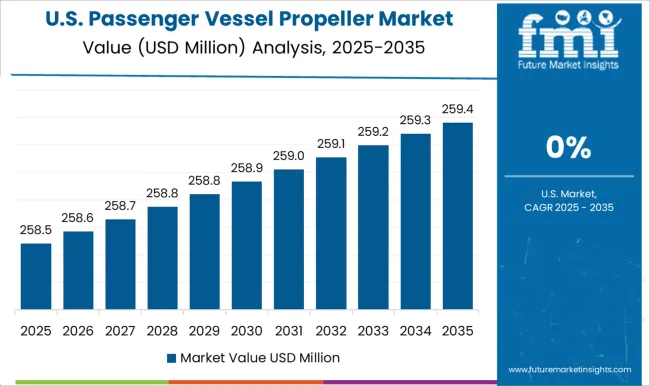
The passenger vessel propeller market in the United States is expected to grow at a CAGR of 3.4%. The USA market remains steady, driven by the increasing demand for eco-friendly and fuel-efficient propulsion systems in the cruise and ferry sectors. The country’s focus on sustainability, coupled with regulatory standards for reducing carbon emissions, continues to contribute to the adoption of advanced passenger vessel propellers. Additionally, the USA market benefits from rising consumer demand for sustainable and energy-efficient travel solutions in the leisure and tourism sectors. Innovations in propulsion technology and increasing investments in marine infrastructure continue to support market growth.
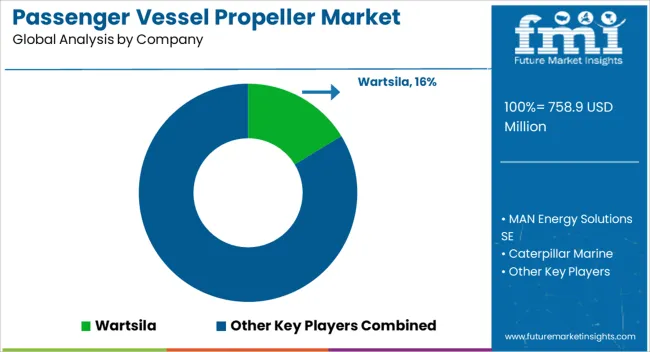
The passenger vessel propeller market is dominated by Wartsila, which leads with its innovative, high-performance propeller solutions used in passenger vessels for efficient propulsion and fuel consumption. Wartsila’s dominance is supported by its extensive expertise in marine technology, global presence, and commitment to providing reliable, energy-efficient propulsion systems that meet the needs of modern shipping and passenger transport. Key players such as MAN Energy Solutions SE, Caterpillar Marine, and Schottel Group maintain significant market shares by offering advanced propeller designs that improve maneuverability, reduce emissions, and enhance overall vessel efficiency. These companies focus on integrating cutting-edge technologies such as hydrodynamic optimization and digital monitoring for better performance. Emerging players like Nakashima Propeller Co., Ltd., VEEM Marine, and Teignbridge Propellers International Ltd. are expanding their market presence by providing specialized passenger vessel propellers designed for niche applications such as high-speed ferries, luxury cruise liners, and environmentally friendly vessels.
Their strategies include offering customizable, cost-effective solutions, improving durability, and focusing on reducing noise and vibration. Market growth is driven by the increasing demand for energy-efficient, low-emission maritime transport, rising passenger travel, and the adoption of eco-friendly technologies. Innovations in propeller materials, propulsion systems, and digital performance monitoring are expected to continue shaping competitive dynamics and fuel further growth in the global passenger vessel propeller market.
| Item | Value |
|---|---|
| Quantitative Units | USD 758.9 Million |
| Vessel | Cruise Ships, Ferries, Yachts, and River Cruise Vessels |
| Propeller Type | Controllable Pitch Propellers (CPP), Fixed Pitch Propellers (FPP), Ducted Propellers, Azimuth Thrusters, and Others |
| Material Type | Nickel-Aluminum Bronze (NAB), Stainless Steel, Composites, and Others |
| Sales Channel | OEMs and Aftermarket |
| Regions Covered | North America, Europe, Asia-Pacific, Latin America, Middle East & Africa |
| Country Covered | United States, Canada, Germany, France, United Kingdom, China, Japan, India, Brazil, South Africa |
| Key Companies Profiled | Wartsila, MAN Energy Solutions SE, Caterpillar Marine, Hyundai Heavy Industries Engine & Machinery, Schottel Group, Nakashima Propeller Co.,Ltd., Mecklenburger Metallguss GmbH, VEEM Marine, Duke Propulsion Technologies, and Teignbridge Propellers International Ltd. |
| Additional Attributes | Dollar sales by propeller type and application, demand dynamics across cruise ships, ferries, and yachts, regional trends in passenger vessel propeller adoption, innovation in high-efficiency and eco-friendly propulsion systems, impact of regulatory standards on emissions and performance, and emerging use cases in autonomous vessels and sustainable maritime transport. |
The global passenger vessel propeller market is estimated to be valued at USD 758.9 million in 2025.
The market size for the passenger vessel propeller market is projected to reach USD 1,123.3 million by 2035.
The passenger vessel propeller market is expected to grow at a 4.0% CAGR between 2025 and 2035.
The key product types in passenger vessel propeller market are cruise ships, ferries, yachts and river cruise vessels.
In terms of propeller type, controllable pitch propellers (cpp) segment to command 36.2% share in the passenger vessel propeller market in 2025.






Our Research Products

The "Full Research Suite" delivers actionable market intel, deep dives on markets or technologies, so clients act faster, cut risk, and unlock growth.

The Leaderboard benchmarks and ranks top vendors, classifying them as Established Leaders, Leading Challengers, or Disruptors & Challengers.

Locates where complements amplify value and substitutes erode it, forecasting net impact by horizon

We deliver granular, decision-grade intel: market sizing, 5-year forecasts, pricing, adoption, usage, revenue, and operational KPIs—plus competitor tracking, regulation, and value chains—across 60 countries broadly.

Spot the shifts before they hit your P&L. We track inflection points, adoption curves, pricing moves, and ecosystem plays to show where demand is heading, why it is changing, and what to do next across high-growth markets and disruptive tech

Real-time reads of user behavior. We track shifting priorities, perceptions of today’s and next-gen services, and provider experience, then pace how fast tech moves from trial to adoption, blending buyer, consumer, and channel inputs with social signals (#WhySwitch, #UX).

Partner with our analyst team to build a custom report designed around your business priorities. From analysing market trends to assessing competitors or crafting bespoke datasets, we tailor insights to your needs.
Supplier Intelligence
Discovery & Profiling
Capacity & Footprint
Performance & Risk
Compliance & Governance
Commercial Readiness
Who Supplies Whom
Scorecards & Shortlists
Playbooks & Docs
Category Intelligence
Definition & Scope
Demand & Use Cases
Cost Drivers
Market Structure
Supply Chain Map
Trade & Policy
Operating Norms
Deliverables
Buyer Intelligence
Account Basics
Spend & Scope
Procurement Model
Vendor Requirements
Terms & Policies
Entry Strategy
Pain Points & Triggers
Outputs
Pricing Analysis
Benchmarks
Trends
Should-Cost
Indexation
Landed Cost
Commercial Terms
Deliverables
Brand Analysis
Positioning & Value Prop
Share & Presence
Customer Evidence
Go-to-Market
Digital & Reputation
Compliance & Trust
KPIs & Gaps
Outputs
Full Research Suite comprises of:
Market outlook & trends analysis
Interviews & case studies
Strategic recommendations
Vendor profiles & capabilities analysis
5-year forecasts
8 regions and 60+ country-level data splits
Market segment data splits
12 months of continuous data updates
DELIVERED AS:
PDF EXCEL ONLINE
Passenger Car Seat Market Forecast and Outlook 2025 to 2035
Passenger Boarding Bridge Market Size and Share Forecast Outlook 2025 to 2035
Passenger Ferries Market Size and Share Forecast Outlook 2025 to 2035
Vessel Tracking Market Size and Share Forecast Outlook 2025 to 2035
Passenger Vehicle ADAS Market Size and Share Forecast Outlook 2025 to 2035
Passenger Vehicles Market Size and Share Forecast Outlook 2025 to 2035
Vessel Traffic Management Market Size and Share Forecast Outlook 2025 to 2035
Passenger Vehicle Telematics Market Size and Share Forecast Outlook 2025 to 2035
Passenger Security Market Size and Share Forecast Outlook 2025 to 2035
Passenger Tire Market Size and Share Forecast Outlook 2025 to 2035
Vessel-sealing Devices Market Trends - Growth & Forecast 2025 to 2035
Assessing Passenger Boarding Bridge Market Share & Industry Trends
Vessel Retrofit Market Growth – Trends & Forecast 2024-2034
Passenger Car Bearing & Clutch Component Aftermarket Growth – Trends & Forecast 2024-2034
CFRP Propeller Shaft Market
Used Passenger Car Sales Market
Marine Vessels Market Size and Share Forecast Outlook 2025 to 2035
Airport Passenger Boarding Bridge Market Size and Share Forecast Outlook 2025 to 2035
Electric Passenger Car MRO Market Growth – Trends & Forecast 2025 to 2035
Satellite Vessel Tracking Market Size and Share Forecast Outlook 2025 to 2035

Thank you!
You will receive an email from our Business Development Manager. Please be sure to check your SPAM/JUNK folder too.
Chat With
MaRIA